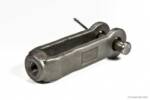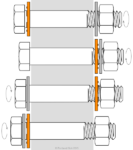Technical FAQs
Class 1 vs 2 Stainless
Is there a way to visually distinguish the difference between a Class 1 and Class 2 stainless steel bolt?Yes, there is. A193 and A320 grades B8 and B8M are assumed to be Class 1 unless otherwise specified. Class 1 fasteners are carbide solution treated, while class 2 fasteners are carbide solution treated and strain hardened. The work hardening that occurs in the manufacturing of Class 2 fasteners increases their strength. Class 2 fasteners... Read more

Shear Plate Dimensions
What are the physical dimensions of a shear plate?The physical dimensions of shear plates are governed by ASTM D5933. Shear plates come in two sizes, 2-5/8” outside diameter and 4” outside diameter. In several cases, we have been asked the dimensions of everything other than the OD and bolt hole. All of those dimensions are listed in the diagrams below. If your project requires... Read more
Ductile Steel
Are ASTM F1554 Grade 55 anchor rods > 2” in diameter a ‘ductile steel element’ per ACI 318-05 Appendix D.1?According to ACI 318-05 Appendix D.1, a “Ductile Steel Element” is an element with a tensile test elongation of at least 14 percent and reduction in area of at least 30 percent. The minimum elongation percentage for any diameter of F1554 Grade 55 anchor rod is 21% and the minimum reduction of area percentage is... Read more

Welding Clevises
Can I weld to a clevis?Technically you should not weld to a clevis which is made of C1035 steel and has a carbon content of approximately 0.35%, too high to be normally considered a weldable material. If the engineer has required welding to the clevis, then a special welding procedure should be followed that is outlined in AWS D1.1 or... Read more

DTI Washers with A490 Bolts
Can A325 Load Indicating Washers be used with A490 structural bolts?Load indicating washers are used to indicate the achievement of a specified minimum bolt tension. The ASTM specification covering load indicating washers is F959 and has two different types; 325 (type 1 and type 3) and 490 (type 1 and type 3). When used, the washer is typically placed beneath the head of the bolt. As the... Read more
1045 Steel for F1554 Grade 55
Can SAE 1045 round bar be used to manufacture F1554 Grade 55 anchor bolt?SAE (AISI) 1045 in an “as rolled” condition will likely not meet the mechanical requirements of ASTM F1554 Grade 55. ASTM F1554 Grade 55 is a finished fastener specification with mechanical and chemical requirements. SAE 1045 has chemical requirements associated with it; however there are no mechanical requirements since it is a raw material specification, not a... Read more

Torque for Stainless Steel
Why does Portland Bolt’s torque chart not have values for stainless steel fasteners?Portland Bolt’s Torque Chart includes approximate torque values for fastener specifications made from carbon steel and alloy steel. We have chosen to exclude torque values related to fastener specification made from stainless steel. The primary reason we have decided to omit stainless fastener specifications from our torque chart is because we are unable to locate... Read more
SAE 4340 and ASTM F1554
Do bolts made from SAE 4340 material meet the requirements of ASTM F1554?I have a client out of Israel and they manufacture equipment for use in power plants. They have a question about anchor bolts in seismic zones. They want to use anchor bolts made from SAE 4340 material and they would like to know if that is equivalent to ASTM F1554 material. Will this material be... Read more

DTI Washer Configuration
I am installing some A325 bolts, and I am using direct-tension-indicator (DTI) washers. Does the DTI replace the F436 washer that I would normally use, or do I still use a standard F436 washer?According to the Research Council on Structural Connections (RCSC December 31, 2009 edition), an F436 washer is used in addition to a DTI washer with an A325 structural bolt. RCSC’s Specification for Structural Joints Using ASTM A325 or A490 Bolts, Section 6 Use of Washers, states that a ASTM F436 washer is always used, but... Read more

Tie Rod Attachment
How do tie rods attach to a structure?Tie rods are attached by sliding a gusset plate or knife plate, which is fastened to a structure, in between the ears of a clevis. A clevis pin or A325 structural bolt, is then assembled through the pin holes on the clevis and through the hole in the plate. Gusset plates are attached to the... Read more
